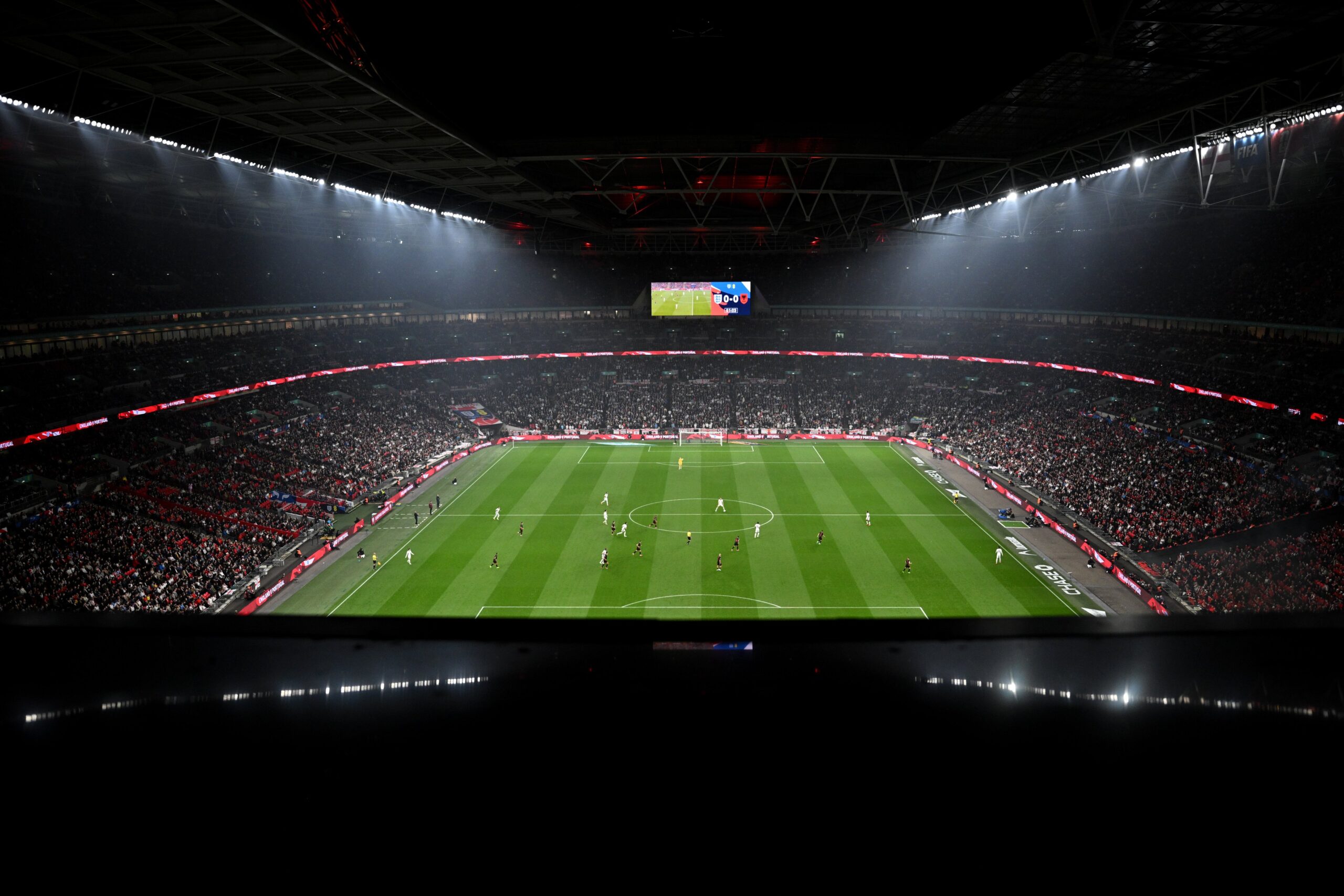
APFA
March 24, 2025
Tuchel’s First England Match Review (vs Albania)
It’s officially the start of a new era in English football, as Thomas Tuchel took charge for his first match as manager of the Three Lions against Albania, leading them to a 2-0 win. The occasion marked the beginning of England’s push towards qualifying for the 2026 World Cup – a task the nation expects to be an easy accomplishment under their new German leader (a touch ironic, isn’t it?).
England currently sit ranked 4th in FIFA’s nation’s ranking system, whilst Albania are a bit further down in 65th following their last place group finish at Euro 2024 – albeit a group of death with Spain, Italy and Croatia. Meanwhile, England haven’t lost a World Cup qualifying match since October 2009 against Ukraine, where they lost 1-0. Therefore, it won’t come as a surprise to say England were strong favourites heading into this game, and they proved why. Goals from debutant Myles Lewis-Skelly and Harry Kane guided England to their 3 points, but what else did we learn from Tuchel’s first game in charge?
Firstly, how did the teams lineup?

Be honest, we were all wondering before the match what system and formation Tuchel was going to use. Would it be a 3-4-3 that won him a Champions League at Chelsea? No. Would it be a 4-2-3-1 reminiscent of his Bayern Munich side? No. How about a 4-3-3 like at PSG? Yes…well, close enough!
Interestingly, a few new names entered the frame in yesterday’s match as Tuchel balanced both experience and youth in a 4-3-3 set-up. Notably, two left footed defenders came into the side in Dan Burn (left centre-back) and Myles Lewis-Skelly (left-back), providing good balance at the back alongside Ezri Konsa and veteran Kyle Walker. This was something clearly missing in Southgate and Carsley’s recent sides. Meanwhile, Declan Rice held-down the middle of the park, with Curtis Jones and Jude Bellingham both given more advanced midfield roles, supported by Rashford and Foden on the wings, and Kane as the focal point up top. No MAJOR surprises if we’re honest.
As for Albania, ex-Brentford player Strakosha started in goal, protected by a back 4 of Balliu, Ajeti, Djimsiti and Aliji. In midfield was their star-man Asllani of Inter Milan, accompanied by Ramadani and Laci. Finally, Ranger’s winger Bajrami, recently transferred Austin FC striker Uzuni, and Gwangju FCs Asani led the front line, although each failed to make a significant impact in front of goal.
Okay, so how did England set up out of possession?
Now, it’s worth noting that Albania only raked up 26% possession throughout the entire match, often trying to counter as quick as possible rather than focusing on a sustained build-up. Yet when they did have the ball, England looked to press in a 4-4-2 shape, deploying Bellingham as a second striker alongside Kane.
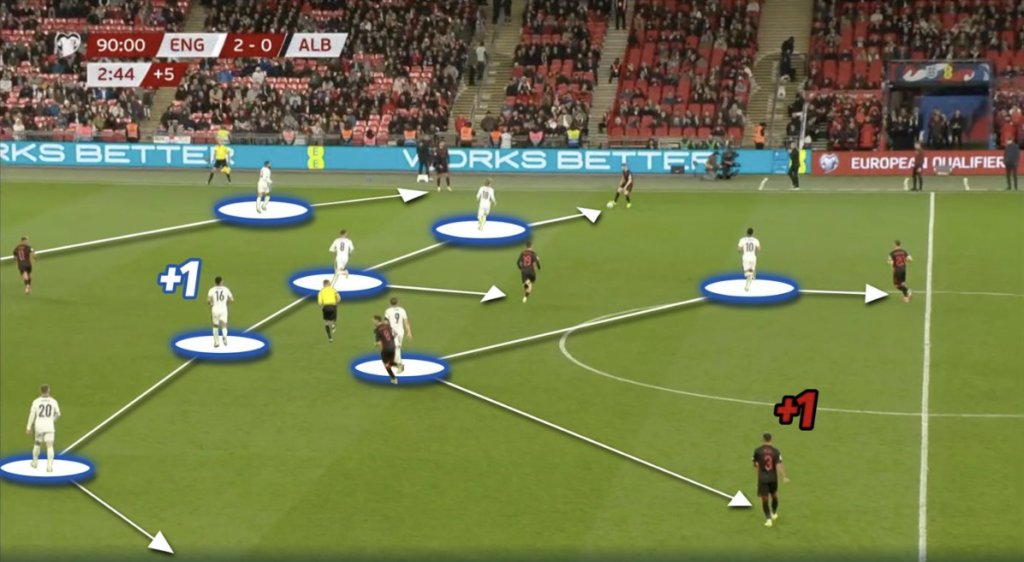
We can see in the image above that 4-4-2 shape from England, granted much later in the game but the principles remained the same throughout. In this system, the side opposite the ball can collapse the pitch, with Kane dropping deeper to man-mark one of Albania’s central midfielders and Bowen tucked in. Bellingham closes off the passing lane back to the centre-back, whilst Henderson is in a position where he can jump onto the other central midfielder when necessary. Reece James (playing left-back) then pushes up to mark the right winger, meaning Rogers (playing right centre-mid) is the spare man to close off the centre of the pitch, forcing Albania to either play over the press or recycle the ball along their backline.
This method consistently prevented Albania from progressing through the thirds with any real threat. In fact, they managed only 31 final third entries compared to England’s 101. When they did opt to go long, the likes of Dan Burn or Ezri Konsa were clear favourites to win the first ball, handing possession back into England’s hands. The issue Albania faced by playing Uzuni as a solo striker was his inability to hold the ball up to facilitate their counter-attacking style, especially when England left both centre-backs deeper to maintain the numerical superiority in these situations. Armando Broja proved slightly more efficient at this, creating a couple of half-chances for his teammates, but again nothing with any real danger for Pickford to have to deal with. In 90 minutes, Albania took only 3 shots, with none on target. Defensively, England were mostly untested, but I don’t see Latvia posing any more of a threat on Monday so it might be a while before we see a proper test of this defensive shape…famous last words?
More importantly, how did England set up in possession?
Well, we tended to see one of two things whilst England had the ball in the first phase:
- A 2-3-5 shape
- A 3-1-6 shape
Both very similar, and ultimately depending on the position of both the full-backs. To start, let’s focus on variation 1 from above – the 2-3-5.
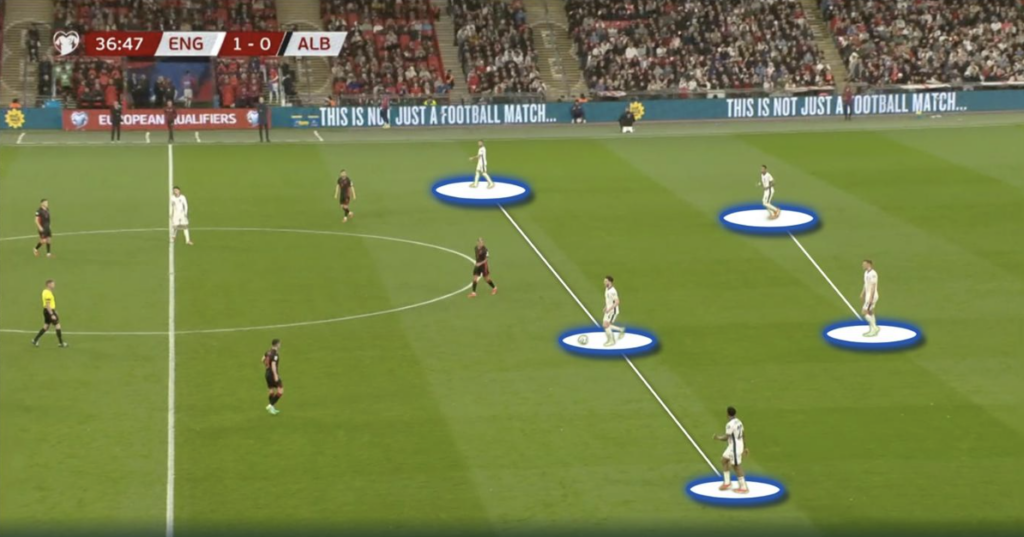
We can see here that both full-backs, Walker and Lewis-Skelly, push up into low-lying positions either side of Declan Rice to create a 2-3 base. In this match, there were 2 benefits in doing so. Firstly, by taking up an inside role, it allowed both of them to dictate the play from a deeper position, where they still had time and space to either play forward, or recycle when needed. Secondly, the importance of defending WITH the ball is something often overlooked in football. It’s a concept people tend to forget, but defensive positioning whilst the team has the ball is imperative to ensure a solid rest-defence which can mop up any potential counter-attack. As Albania primarily looked to counter when they could, Lewis-Skelly and Walker would quickly recover possession. From here, they could then look to progress the ball back into the final third as soon as possible, sustaining consistent attacking pressure to beat Albania’s low block.
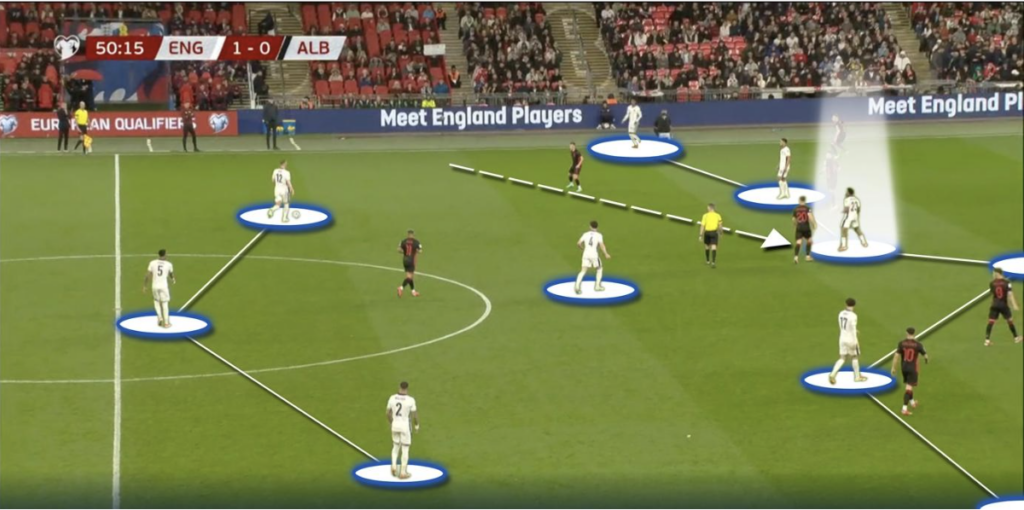
At the start of the second half, Tuchel seemed to make a small adjustment to promote Lewis-Skelly getting higher up the pitch on a more consistent basis. As we can see from above, Walker has tucked into the right of a back 3, forming a 3-1 base, leading us onto variation number 2 – the 3-1-6. With Albania typically sitting in a 5-4-1 low-block, England began committing to 6 men in the attacking line. This allowed Bellingham or Jones, or both, to drop in between the lines to get hold of the ball and drag the Albanian defenders out of position.
It worked. Channels opened up for the likes of Lewis-Skelly to attack, causing chaos and confusion primarily in the half-spaces, allowing some seamless rotations between himself, Rashford and Bellingham. In the image above, Lewis-skelly has made an inverted run, dragging Ramadani with him, whilst Albania’s Balliu and Ajeti are occupied with covering Bellingham and Rashford, gifting Rice acres of space to receive the ball in the middle of the pitch to find a progressive pass.
The attacking transition
Beating a low-block is never easy. Finding overloads or balls in-behind are crucial to drag that defensive line as far apart as possible, opening up gaps between the lines that can be taken advantage of. Successfully doing this, however, can be a challenge for even the best of teams. Tuchel still found a way, and did so in a couple of different methods.
The first of which is something we were all waiting for, to be honest – Harry Kane. Need I really say much more…
Arguably one of the best modern-day strikers, Kane possesses a passing range that on his day is unstoppable. Under Tuchel during his first season at Bayern, Kane racked up 56 goal contributions in only 45 games. A sensational return, which to think still wasn’t enough to win the Bundesliga that season. But clearly, Tuchel understands how to get the best out of the Englishman, and we saw this again last night.
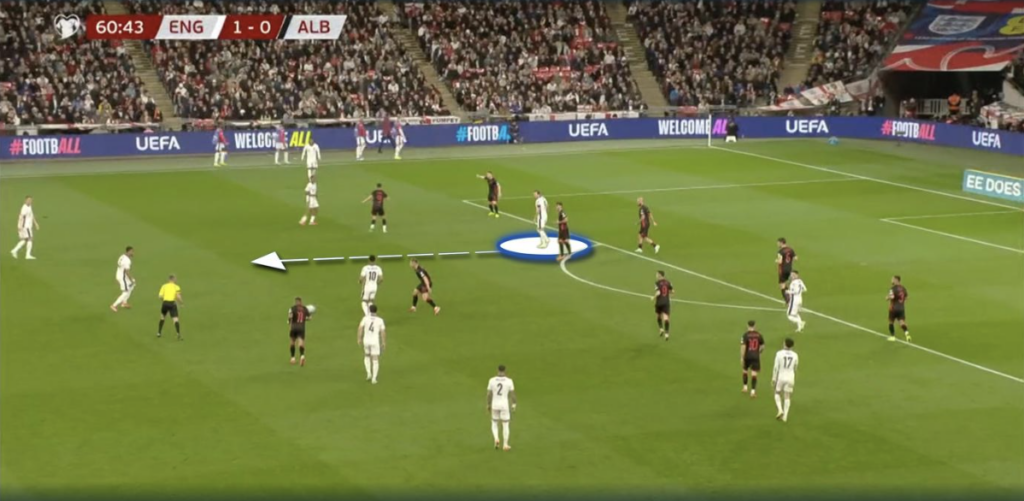
You can see here Lewis-Skelly and Bellingham have created some separation between them, creating a large area for Kane to drop into. This could either open up a channel for Lewis-Skelly to run in behind, or it gives Kane space in which to opperate and find a penetrative passes. Given the topic of conversation, you won’t be shocked to hear it’s the latter that happens.
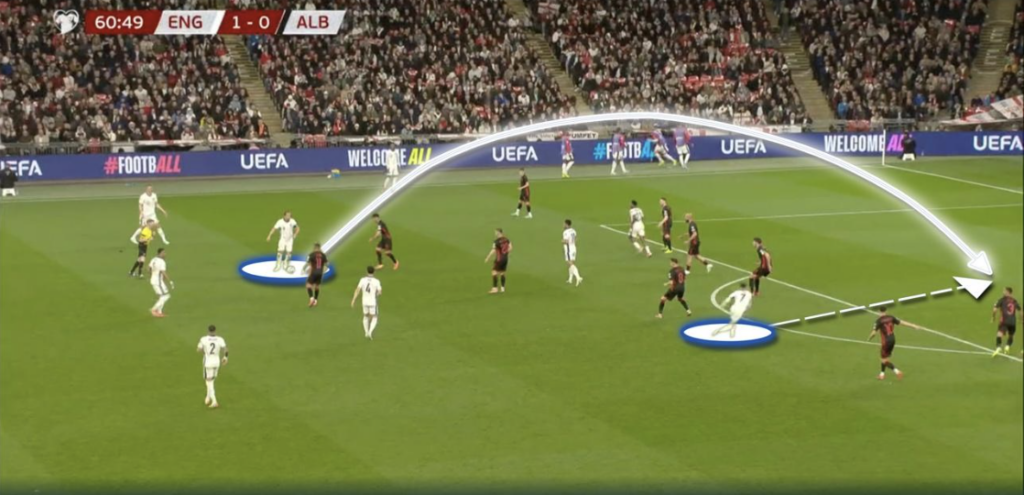
Kane drops into midfield, and Foden makes a brilliant run between the defenders into the box. Similarly, you can’t see it in the frame, but Jones makes a run towards the back post too. Kane plays a lovely floated pass over the top, and on another day the chance could easily have been converted.
The alternative method of getting in behind the Albanian low-block included well timed runs from the opposite-side full-back. As we established earlier, the ball-side fullback stayed deeper, whilst the other was given the freedom to join the attacking line. The role alternated between Lewis-Skelly and Walker, but on this occasion Lewis-Skelly got his debut goal from doing just this.
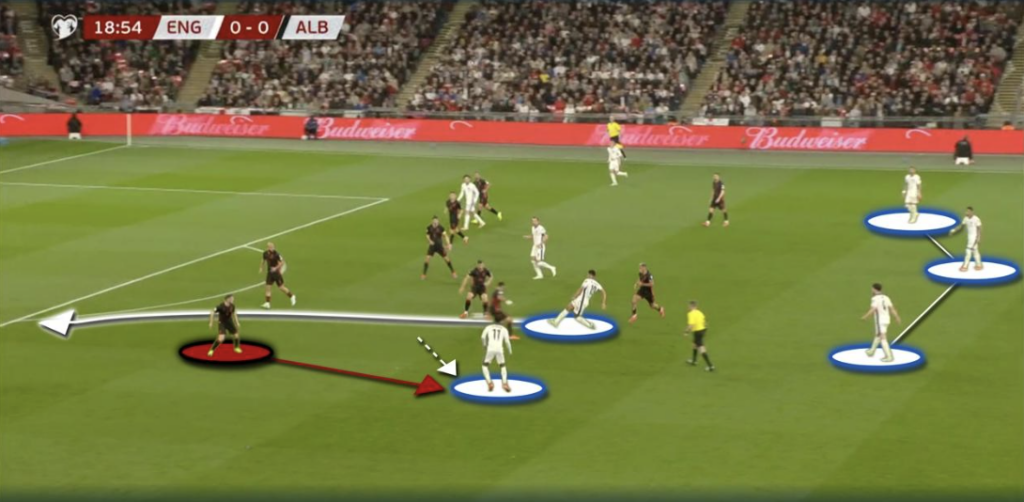
The rotations and movements from all of England’s left-side is imperative to constructing this chance. To begin, Rice drops deeper alongside the defenders, thus vacating the midfield zone. This leaves an area for Bellingham to drop into and pick up the ball. As Bellingham’s role was to occupy the left half-space, Rashford has inverted from left wing into this channel to fill that vertical zone, opening up space out wide for Lewis-Skelly to make an out-to-in run.
I’d also like to highlight the movement of Rashford in this scenario. Albania defended in a 5-4-1, meaning their wingers had to track back into situational wing-backs, and in this case it was Asani who was tracking the left-back. Prior to the assist, Rashford is stood right in the middle of the passing lane from Bellingham to Lewis-Skelly. When he realises this, he drops wider and deeper by a few yards, both dragging out Balliu from a deeper defensive position, but it also opens up that passing lane for Bellingham to find the assist.
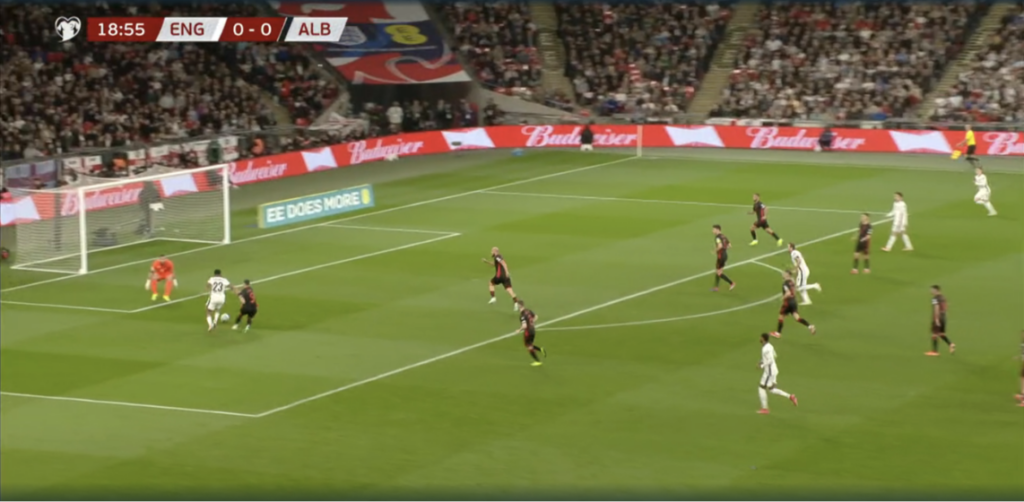
A touch from class from Real Madrid’s midfielder meant the perfectly weighted pass fell into the feet of the Arsenal wonderkid, who very calmly tucks it under Strakosha’s legs into the net. Phwoar, some composure from an 18 year old on their national debut.
Should we have expected more?
To answer bluntly, yes. It was a dominant display from England, and Tuchel certainly gave a performance that will have gotten England fans excited. Compared to recent managers, Tuchel showed that a balanced lineup can exist with this squad, but it was far from perfect. A lack of movement and runs (other than from Walker or Lewis-Skelly) often meant that attacks would fall apart, with play being recycled until another opportunity presented itself. It was an improvement, but certainly in the wide areas it lacked creativity.
Foden attempted 1 dribble in his time on the pitch, and it was not a successful one at that. Rashford was slightly better, yet still lacked real quality in 1v1 moments. It’s these positions where fans will expect more from their wingers, especially in moments where the team needs to find a goal, and Tuchel agreed in his post-match interview.
With Palmer, Saka and Gordon all yet to have a proper go themselves, I have no doubt they’ll provide that extra quality in the wide areas that was missing last night, but it poses a familiar question: What is Foden’s role in this England squad? Winger? Unlikely. False 9? Very unlikely. In the 10? Only behind Palmer and Bellingham when everyone is available. Definitely one to keep an eye on.
We can assume a heavily rotated side will play Latvia on Monday night, maybe then we’ll get a glimpse of what else to expect under Tuchel. So far, though, so good, and certainly a good tactical audition from the German.
Written by APFA Member, Cameron Schultz
Want to Break Down a Game as Expertly as Cameron Does in This Article?
Our online courses offer unmatched guidance across key areas of football analysis, helping you sharpen your skills and earn a certification to advance your development as an analyst.
